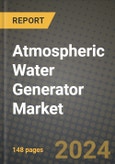Atmospheric Water Generator Market
The atmospheric water generator (AWG) market is gaining momentum as water scarcity and demand for sustainable water sources intensify. AWGs extract moisture from the air and condense it into drinkable water, making them ideal for regions with unreliable or contaminated water supplies. Applications span residential, commercial, and military sectors, particularly in arid and disaster-prone regions.In 2024, innovations in energy efficiency and solar-powered AWGs enabled broader adoption, especially in off-grid areas. Governments and NGOs also began deploying AWGs for emergency response and humanitarian aid. Manufacturers focused on reducing production costs, improving scalability, and enhancing water purification capabilities to meet safety standards.
As we move into 2025 and beyond, the market is expected to expand rapidly with advancements in nanotechnology, air filtration, and low-energy compressors. Demand from industrial users, such as hotels and agricultural setups, will also rise. However, high electricity consumption and performance dependency on humidity levels remain technical and commercial challenges for widespread use.
Key Insights - Atmospheric Water Generator Market
- Emergence of solar and hybrid-powered AWGs for off-grid applications.
- Integration of smart sensors and real-time water quality monitoring.
- Increased use of AWGs in emergency and humanitarian operations.
- Development of compact, portable AWGs for personal and military use.
- Public-private partnerships for AWG deployment in water-scarce regions.
- Rising global water scarcity and demand for alternative sources.
- Technological advancements improving water yield and purification.
- Government incentives for sustainable water solutions.
- Demand from disaster-prone and drought-affected regions.
- High energy consumption and dependence on humidity levels can limit efficiency and operational cost-effectiveness.
Future of the Atmospheric Water Generator Market - Opportunities and Challenges
Growth momentum is expected to remain strong, propelled by decarbonization initiatives, electrification of transport, modernization of industrial processes, and increasing adoption of digital and automated solutions. The acceleration of renewable integration, grid modernization, and distributed storage is unlocking new applications for Atmospheric Water Generator technologies. Expanding investments in energy transition, clean mobility, and industrial modernization programs across emerging economies are also key drivers.However, challenges persist. Heightened raw material price volatility, tightening global regulations, supply-demand imbalances, and intense competition pose risks to profitability. Geopolitical uncertainties, trade restrictions, and currency fluctuations further complicate planning. To remain competitive, players must align with sustainability standards, adapt to localized compliance regimes, and manage rising operational costs effectively.
Atmospheric Water Generator Market Analytics
The report employs rigorous tools, including Porter’s Five Forces, value chain mapping, and scenario-based modeling, to assess supply-demand dynamics. Cross-sector influences from parent, derived, and substitute markets are evaluated to identify risks and opportunities. Trade and pricing analytics provide an up-to-date view of international flows, including leading exporters, importers, and regional price trends.Macroeconomic indicators, policy frameworks such as carbon pricing and energy security strategies, and evolving consumer behavior are considered in forecasting scenarios. Recent deal flows, partnerships, and technology innovations are incorporated to assess their impact on future market performance.
Atmospheric Water Generator Market Competitive Intelligence
The competitive landscape is mapped through the proprietary frameworks, profiling leading companies with details on business models, product portfolios, financial performance, and strategic initiatives. Key developments such as mergers & acquisitions, technology collaborations, investment inflows, and regional expansions are analyzed for their competitive impact. The report also identifies emerging players and innovative startups contributing to market disruption.Geographic Coverage
- North America: United States, Canada, Mexico
- Europe: Germany, France, UK, Italy, Spain, Rest of Europe
- Asia-Pacific: China, India, Japan, South Korea, Australia, Rest of APAC
- Middle East & Africa: GCC, North Africa, Sub-Saharan Africa
- South & Central America: Brazil, Argentina, Rest of the region
Research Methodology
This study combines primary inputs from industry experts across the Atmospheric Water Generator value chain with secondary data from associations, government publications, trade databases, and company disclosures. Proprietary modeling techniques, including data triangulation, statistical correlation, and scenario planning, are applied to deliver reliable market sizing and forecasting.Customization Options
The report can be tailored with additional modules such as:- Detailed trade & pricing analytics
- Technology adoption roadmaps and patent analysis
- PESTLE & macroeconomic impact analysis
- Country-specific forecasts and regulatory mapping
- Capital requirements, ROI models, and project feasibility studies
Key Questions Addressed
- What is the current and forecast market size of the Atmospheric Water Generator industry at global, regional, and country levels?
- Which types, applications, and technologies present the highest growth potential?
- How are supply chains adapting to geopolitical and economic shocks?
- What role do policy frameworks, trade flows, and sustainability targets play in shaping demand?
- Who are the leading players, and how are their strategies evolving in the face of global uncertainty?
Atmospheric Water Generator Market Segmentation
By Type (Cooling Condensation, Wet Desiccation), By Application (Industrial, Commercial, Residential)This product will be delivered within 1-3 business days.
Table of Contents
Companies Mentioned
- Water-Gen Ltd.
- Akvo Atmospheric Water Systems Pvt. Ltd.
- Drinkable Air Technologies
- SOURCE Global
- Ray Agua
- Island Sky Corporation
- Water Generating Systems LLC
- WAIEA Water Solutions
- EcoloBlue
- Drupps
- Watair Inc
- WaterMaker India Pvt Ltd
- Planets Water
- Fujian Yuxin Electronic Co Ltd
- Akvosphere
- Bestway (Shanghai)Technology Co. Ltd
- Guangdong Laswim Water Environment Equipment Co. Ltd
- Dew Point Manufacturing
- Water Technologies International Inc
- Skywater Air Water Machines
- Hendrx Water
- Energy and Water Development Corp. (Eawc)
- Genaq Technologies S.L.
- Air 2 Water Solutions
- AeroNero
- Tsunami Products Inc
- AquaViable Solutions Inc
- Canadian Dew Technologies Inc
- Green Technology Global Inc
- Satus Ager S.A
- Tecnoseeds
- GlobeNatural
- De Alimentos
- Adm Do Brasil Ltda
- GENAQ
- H2O Biofouling Solutions B.V.
- Eshara Water
- Buserve Limited
- Aqua Air Africa.








